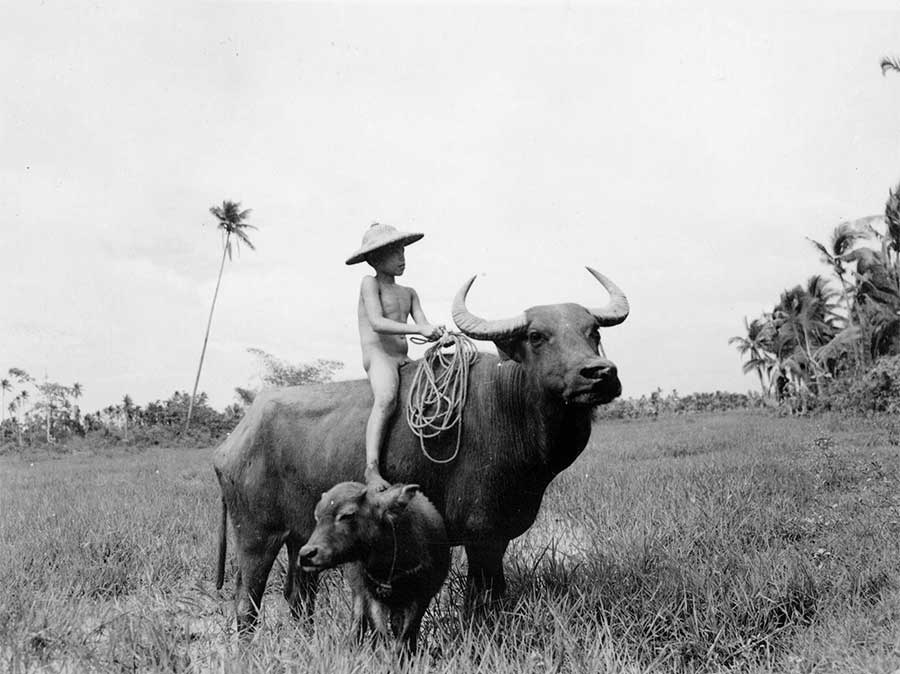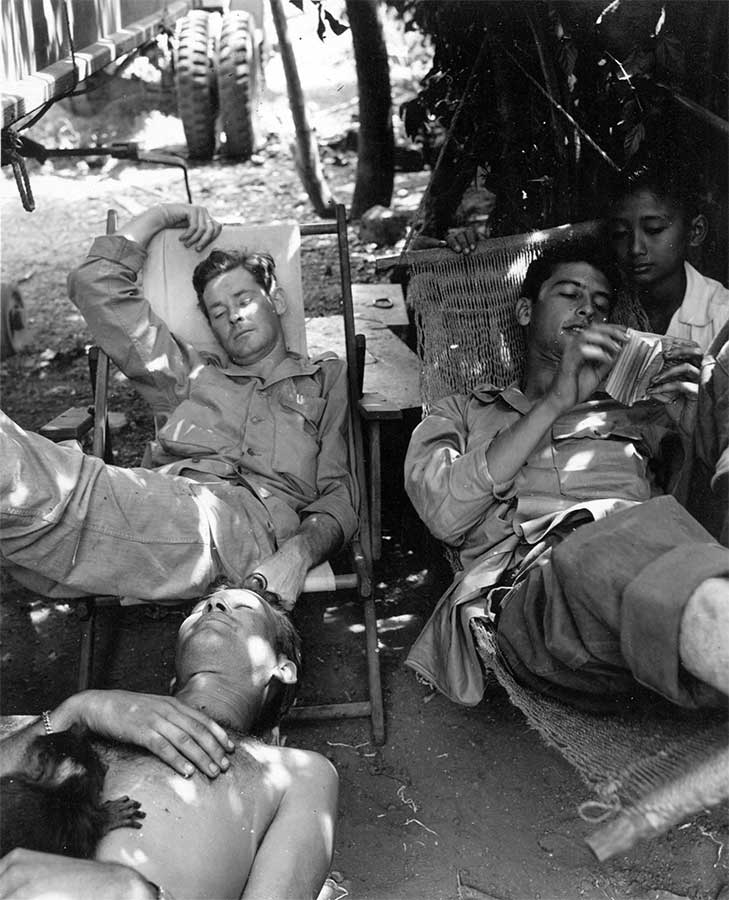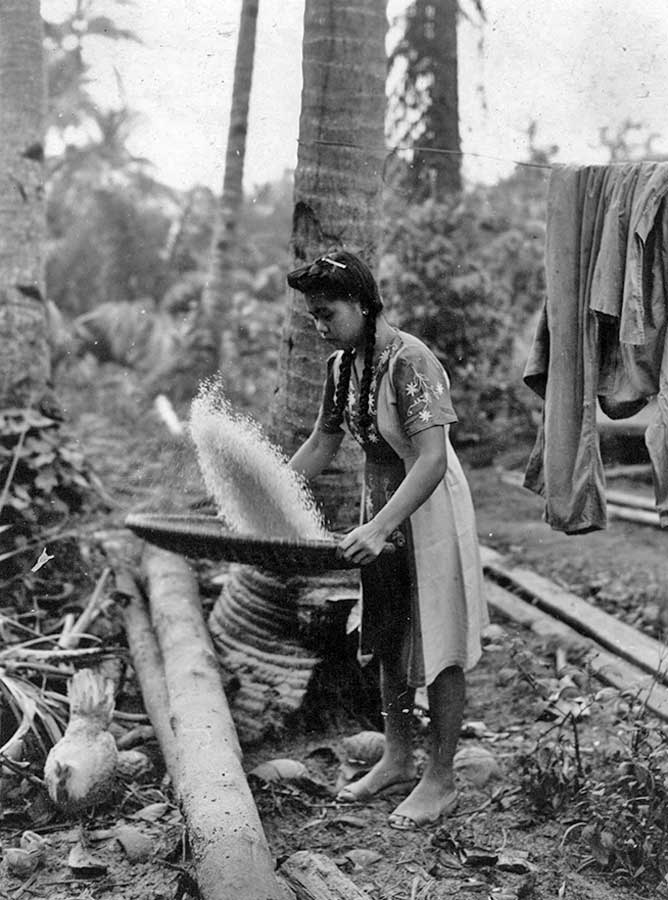Rice Processing
[Part 1 can be found here.] The villagers continued farming rice, their subsistence crop, during the Japanese occupation, which kept the food supply from reaching starvation levels. Diaz indicates that harvesting season occurs from November through January (74), which coincided with my father’s tenure on the islands. Figures 8, 9, 10, 11, and 12 illustrate the different stages of rice processing in Tacloban.
The villagers, both men and women, pound the rice free of its husks (Figures 9 and 10). Then the women usually sift it in a winnowing basket (Figure 11 and above) and lay it out to dry (Figure 12 and above). Diaz reports a similar process for southern Luzon, except that husk separation is accomplished by stomping on the rice stalks. He labels the winnowing basket a bilao, and the drying mat a banig.
Since Luzon belongs to a different ethno-linguistic group than Leyte, I doubt that these terms are as universal as he implies (24). However, Diaz includes sketches of the implements, which look identical to the ones in the snapshots. This particular sequence also clearly illustrates the different styles of palm thatch housing and depicts the women’s bakia.
The villagers carry an unidentified crop resembling a tuber in Figure 13 and below. Diaz identifies a type of yam harvested in southern Luzon called ubi. He does not describe its appearance but does report that the men picked it in January (77), the month this picture was taken

Washing at the River—A Glimpse of Religion
The women and children washed clothing daily during Tacloban’s occupation by American forces. Nurge also mentions the increased activity: “The army, needing washerwomen, laborers, and other workers, provided jobs for many. Food, clothing, and money ‘flowed like rain to everyone,’ according to one enraptured informant” (15).
The enlisted men usually paid the villagers with cigarettes and clothing, and the woman in Figure 15 can be clearly seen smoking a cigarette and wearing battle fatigues. An evident contrast exists between the traditional bamboo hat worn by the women in the foreground and the army cap adopted by the woman in the background of Figure 14.
Figure 16 keenly reflects my father’s pre-war profession as a portrait artist. This woman, who wears a Catholic medallion around her neck, has resourcefully turned a pleated skirt into a dress.
All washing appears to take place under or near the same bridge. Its apparent popularity with the villagers is due to the closeness of flowing water and rocks.
A roadside shrine looks down on the washers from the backdrop of Figures 14 and 18. The villagers devotion to religion impressed my agnostic father, and he recalls that natives with whom he had contact were all Catholic. He did not recall any evidence of spirit or ancestor worship, but such reverence would likely be personal, closed to the scrutiny of outsiders. The October 7, 1945 edition of 4026 Signal Photo Battalion News reported that
the Philippine population is 92% Christian, 4% Mohammedan and 4% Pagan…only about 2400 of the 7000 islands are named…Manila is about equal to San Francisco in population, but 3/4 of the city is now in ruins.
A Close Encounter With Carabao
Young boys, such as the one in the Figures 19 and 20, mainly attended the family carabao (water buffalo)—washing and pasturing it. Carabao were fairly common in Tacloban during the American occupation, and most GIs found them quite astonishing.
These lads have themselves quite a time. The carabou don’t seem to mind. Philippines 1945.

The children’s lack of fear with the animals especially impressed my father. Control of the carabao was achieved by stringing a rope through one nostril and knotting it in the other, as seen in Figure 19. The children’s nakedness was not uncommon, though most children wore t-shirts, as Nurge mentions. Adults seldom rode the carabao in Tacloban.
The most amusing anecdote my father recounted during our interviews involved the GIs overwhelming desire for some “real food” after having eaten from cans for several weeks before landing at Tacloban.
An enterprising villager learned of the Americans penchant for “steak and eggs” and soon hung a sign claiming to serve them in front of his sari sari. The eggs, in fact, were delicious, from local hens.
However, the “steak” was really carabao meat, and the vilest, toughest stuff my father had ever eaten. He commented it tasted like buffalo meat, only much worse, and did not agree with many of the soldiers’ stomachs. The villager, however, must have done well, considering the high value placed on carabao as draft animals.
As Nurge points out “today [1955] the liberation is remembered as a time of prosperity and plenty . . . The American soldiers, known as GIs, were generous spenders and did not cavil at high prices” (15). Obviously, the Americans paid for their meat penchant in more ways than one.

A Personal Epilogue
The frustration of this project involved the paradox of detail—so much and so little. Pictures can be both taken and interpreted from a multitude of angles, yet still miss a crucial point, as I feel I have done.
The people on whom the lens concentrates for an instant almost always remain “the other” to the photographer. They are seldom given a chance to caption their own pictures. Since my father shot pictures of both “the other” and “the enemy,” war impersonalized both to a much greater degree. A certain awkwardness can be detected in some of the snapshots—does it come from the subject or the photographer?
My father never really recovered from the overwhelming circumstances into which our government dispatched him at such a young age. Only since Viet Nam has awareness for the plight of veterans of and refugees from war reached the public eye. My father at first refused to discuss his pictures—he considered them “rubbish.”
But he became more animated when I lead the conversation with innocuous technical comments and questions. He corrected my pronunciation of “Tacloban,” lamented the lack of good food, praised the state of the art camera assigned to him. But ultimately, he returned to atrocities he had recorded. I could only sustain his attention for five to ten minutes before his mind turned to darker details. It was difficult and heartbreaking.
Yet these pictures persist in all their awkward humanity, both my father’s and that of the Tacloban villager’s. They constitute only 20 of over 200 in my father’s collection, which he bequeathed to me a decade ago. I feel strongly that they must be preserved both for their humanity and lack of it, so we never forget that war involves people no different from ourselves.
Thank you for giving me a chance to begin.
Sources
Diaz, Ralph C. and Horst and Judith Von Oppenfeld. Case Studies of Farm Families, Laguna Province, Philippines. Laguna: University of the Philippines, 1962.
Nurge, Ethel. Life in a Leyte Village. Seattle: University of Washington Press, 1965.
